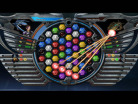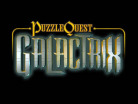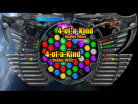- CLASSIC MAGAZINES
- REVIEW CREW
A show recapping what critics thought back
when classic games first came out! - NEXT GENERATION'S BEST & WORST
From the worst 1-star reviews to the best
5-stars can offer, this is Next Generation! - NINTENDO POWER (ARCHIVE)
Experience a variety of shows looking at the
often baffling history of Nintendo Power! - MAGAZINE RETROSPECTIVE
We're looking at the absolutely true history of
some of the most iconic game magazines ever! - SUPER PLAY'S TOP 600
The longest and most ambitious Super NES
countdown on the internet! - THEY SAID WHAT?
Debunking predictions and gossip found
in classic video game magazines! - NEXT GENERATION UNCOVERED
Cyril is back in this spin-off series, featuring the
cover critic review the art of Next Generation! - HARDCORE GAMER MAGAZING (PDF ISSUES)
Download all 36 issues of Hardcore Gamer
Magazine and relive the fun in PDF form!
- REVIEW CREW
- ELECTRONIC GAMING MONTHLY
- ELECTRONIC GAMING MONTHLY RANKS
From Mario to Sonic to Street Fighter, EGM
ranks classic game franchises and consoles! - ELECTRONIC GAMING MONTHLY BEST & WORST
Counting down EGM’s best and worst reviews
going year by year, from 1989 – 2009! - ELECTRONIC GAMING BEST & WORST AWARDS
11-part video series chronicling the ups and
downs of EGM’s Best & Worst Awards!
- ELECTRONIC GAMING MONTHLY RANKS
- GAME HISTORY
- GAME OVER: STORY BREAKDOWNS
Long-running series breaking down game
stories and analyzing their endings! - A BRIEF HISTORY OF GAMING w/ [NAME HERE]
Real history presented in a fun and pithy
format from a variety of game historians! - THE BLACK SHEEP
A series looking back at the black sheep
entries in popular game franchises! - INSTANT EXPERT
Everything you could possibly want to know
about a wide variety of gaming topics! - FREEZE FRAME
When something familiar happens in the games
industry, we're there to take a picture! - I'VE GOT YOUR NUMBER
Learn real video game history through a series
of number-themed episodes, starting at zero! - GREAT MOMENTS IN BAD ACTING
A joyous celebration of some of gaming's
absolute worst voice acting!
- GAME OVER: STORY BREAKDOWNS
- POPULAR SHOWS
- DG NEWS w/ LORNE RISELEY
Newsman Lorne Riseley hosts a regular
series looking at the hottest gaming news! - REVIEW REWIND
Cyril replays a game he reviewed 10+ years
ago to see if he got it right or wrong! - ON-RUNNING FEUDS
Defunct Games' longest-running show, with
editorials, observations and other fun oddities! - DEFUNCT GAMES QUIZ (ARCHIVE)
From online quizzes to game shows, we're
putting your video game knowledge to the test!- QUIZ: ONLINE PASS
Take a weekly quiz to see how well you know
the news and current gaming events! - QUIZ: KNOW THE GAME
One-on-one quiz show where contestants
find out if they actually know classic games! - QUIZ: THE LEADERBOARD
Can you guess the game based on the classic
review? Find out with The Leaderboard!
- QUIZ: ONLINE PASS
- DEFUNCT GAMES VS.
Cyril and the Defunct Games staff isn't afraid
to choose their favorite games and more! - CYRIL READS WORLDS OF POWER
Defunct Games recreates classic game
novelizations through the audio book format!
- DG NEWS w/ LORNE RISELEY
- COMEDY
- GAME EXPECTANCY
How long will your favorite hero live? We crunch
the numbers in this series about dying! - VIDEO GAME ADVICE
Famous game characters answer real personal
advice questions with a humorous slant! - FAKE GAMES: GUERILLA SCRAPBOOK
A long-running series about fake games and
the people who love them (covers included)! - WORST GAME EVER
A contest that attempts to create the worst
video game ever made, complete with covers! - LEVEL 1 STORIES
Literature based on the first stages of some
of your favorite classic video games! - THE COVER CRITIC
One of Defunct Games' earliest shows, Cover
Critic digs up some of the worst box art ever! - COMMERCIAL BREAK
Take a trip through some of the best and
worst video game advertisements of all time! - COMIC BOOK MODS
You've never seen comics like this before.
A curious mix of rewritten video game comics!
- GAME EXPECTANCY
- SERIES ARCHIVE
- NINTENDO SWITCH ONLINE ARCHIVE
A regularly-updated list of every Nintendo
Switch Online release, plus links to review! - PLAYSTATION PLUS CLASSIC ARCHIVE
A comprehensive list of every PlayStation
Plus classic release, including links! - RETRO-BIT PUBLISHING ARCHIVE
A regularly-updated list of every Retro-Bit
game released! - REVIEW MARATHONS w/ ADAM WALLACE
Join critic Adam Wallace as he takes us on a
classic review marathon with different themes!- DEFUNCT GAMES GOLF CLUB
Adam Wallace takes to the links to slice his way
through 72 classic golf game reviews! - 007 IN PIXELS
Adam Wallace takes on the world's greatest spy
as he reviews 15 weeks of James Bond games! - A SALUTE TO VAMPIRES
Adam Wallace is sinking his teeth into a series
covering Castlevania, BloodRayne and more! - CAPCOM'S CURSE
Adam Wallace is celebrating 13 days of Halloween
with a line-up of Capcom's scariest games! - THE FALL OF SUPERMAN
Adam Wallace is a man of steel for playing
some of the absolute worst Superman games! - THE 31 GAMES OF HALLOWEEN
Adam Wallace spends every day of October afraid
as he reviews some of the scariest games ever! - 12 WEEKS OF STAR TREK
Adam Wallace boldly goes where no critic has
gone before in this Star Trek marathon!
- DEFUNCT GAMES GOLF CLUB
- DAYS OF CHRISTMAS (ARCHIVE)
Annual holiday series with themed-episodes
that date all the way back to 2001!- 2015: 30 Ridiculous Retro Rumors
- 2014: 29 Magazines of Christmas
- 2013: 29 Questionable Power-Ups of Christmas
- 2012: 34 Theme Songs of Christmas
- 2011: 32 Game Endings of Christmas
- 2010: 31 Bonus Levels of Christmas
- 2009: 30 Genres of Christmas
- 2008: 29 Controls of Christmas
- 2007: 34 Cliches of Christmas
- 2006: 33 Consoles of Christmas
- 2005: 32 Articles of Christmas
- 2004: 31 Websites of Christmas
- 2003: 29 Issues of Christmas
- 2002: 28 Years of Christmas
- 2001: 33 Days of Christmas
- NINTENDO SWITCH ONLINE ARCHIVE
- REVIEW ARCHIVE
- FULL ARCHIVE
Puzzle Quest Galactrix
To say that I loved Puzzle Quest: Challenger of the Warlords would be a gross understatement. When I first got the preview build of the PSP game I instantly fell in love, shouting my admiration from the rooftops. Over the course of 2007 I must have put hundreds of hours into that game, which was a large contributing factor to why I named it my game of 2007. I have an emotional connection to the game as well; when I suffered second degree burns on my right hand, Puzzle Quest DS was the only game I could play. Between the two portable versions and the Xbox Live Arcade expansion pack, I put more time into this little puzzler than just about any other game.
So given my love and excitement for the game, you might think that I would automatically love D3's brand new spin-off, Puzzle Quest Galactrix. After all, it takes everything that was good about the original Puzzle Quest and trades in the fantasy for the sci-fi (or, if you know you're classic RPGs, it trades "Fantasy" for "Phantasy"). But alas, there's just something about this 2009 model that isn't the same. It looks and feels like Puzzle Quest, but there are enough changes to keep it from living up to my (albeit lofty) expectations.
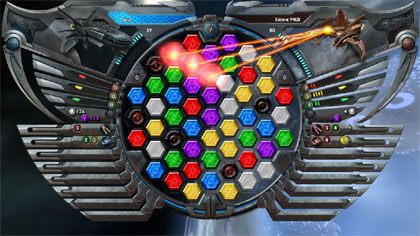
As you can tell from the name, Puzzle Quest Galactrix takes place in space. You play one of several young pilots who just graduated from the Space Academy and is looking to earn some money around the solar system. The story is generic sci-fi through and through, and like the original game, it's easy to avoid. I'm sure there are people that will find something to like about the endless conversations these unlikable characters have, but for me the stories have always been inconsequential to the fun of the game.
This time around you are free to move around the entire galaxy. You use a gigantic map full of various systems, from Talus to Gemini to Alpha Centauri all the way down to Gehenna. Each of these systems has a series of planets, moons and space stations to visit. You can mine for minerals on the various moons, search for missions on the planets and take on any number of warships. In a lot of ways this map is no different from what we saw in the original Puzzle Quest, but there's definitely something cool about tooling around such an expansive solar system.
Much like the first game, the one on one combat is the real draw. And while the basic idea remains the same (match puzzle pieces to inflict enough damage to take out your opponent), the actual combat is a bit different. In the original Puzzle Quest you match pieces on a Bejeweled-style game board. However, in this game you are playing in a Hexic-style board, that is to say instead of only having four directions to match, you now have to deal with six. At first this seems like an interesting twist on the original gameplay, but before long I started to have major issues with this approach.
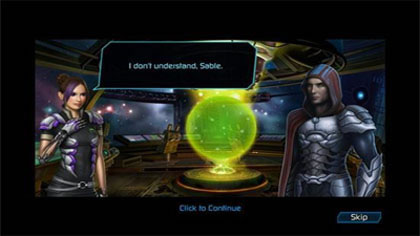
The biggest problem is that it takes a simple concept and makes it too complicated. In the first game you always knew which way the tiles were going to fall (from the top), however in this game you really have to pay attention to the direction of the incoming tiles. You manipulate the tile direction based on how you move. For example, if you move the tile left, the new tiles will come from the left. On paper that sounds simple enough, but I found that I would often forget this rule and have trouble planning ahead. I suppose with practice I will get better at adhering to that rule, though this added complication didn't add anything to the gameplay.
The brand new board also means that more of the game is dependent on luck. Now I won't lie to you, there were times when I felt like the computer was cheating. But this takes that complaint to a whole new, um, solar system. No matter how strong my little spaceship got, I always felt like the computer had an unfair advantage. That's certainly not the attitude I wanted to take into each battle, but I couldn't help but feel that way after only a few missions.
Much like the original Puzzle Quest, each one of the tiles is vitally important to the match. Obviously there are the attack tiles, which are denoted by number tiles. The object is to match three (or more) of these numbered tiles up to do damage. Whatever the three (or more) numbers add up to is the amount of damage you will take off. The trick this time around is that most enemy ships will have a certain level of force fields that will need to be taken down. Once you take down the force field you are free to start damaging the ship, until one of your ships is destroyed.
But don't worry too much about losing your shields, because Puzzle Quest Galactrix allows you to repair your force fields by matching blue tiles. Other tiles are for your special attacks, which will be immediately recognizable to anybody who played the first game. You can also earn experience, which means that even if you lose the battle you will still get something out of it. Even though I'm disappointed by the new game board, I am a big fan of the shield system and feel that there are some improvements to the tile system that should be brought up to over, better Puzzle Quest games.
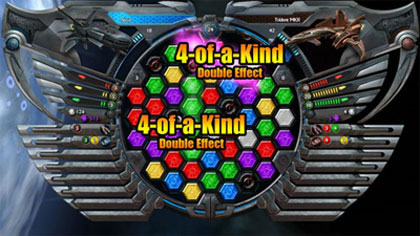
Puzzle Quest Galactrix does make an attempt to spice things up with some variety. While you will still need to take down enemy spaceships in a one-on-one duel to the death, the game offers a lot of other mini-games to keep you entertained. The most common mini-game comes when you attempt to open up the various "Leap Gates" linking the various galaxies. To hack these gates you are given a standard board and a bunch of colors you need to match in order. For example, you might be asked to match green, silver and then blue. While you might be able to match silver and blue, you will first need to match green in order to move over to the other two colors.
Another mini-game has you mining moons for a variety of different valuables (minerals, gold, isotopes, etc.) that can be traded, sold and used in completing your missions. These mini-games feel like a throwback to the first Puzzle Quest, where you go in and match whatever valuables you want until you run out of choices. These various mini-games are fun diversions, but they aren't as much fun as battling other spaceships.
On top of an absolutely gigantic single player story, you can also go head to head with your friends. Of course, much like the first game, you really need to find somebody that you are equal to in order to have a fun time. It's a shame that the game doesn't allow for more even battles, but that's just not the way Puzzle Quest has been. Hopefully when they get around to developing the next game they'll address this concern.
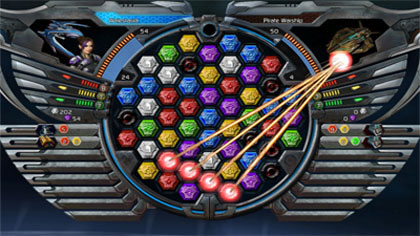
The graphics and sound are about what you would expect from a Puzzle Quest game, which is to say that you will get a lot of drawn images standing and talking while cheesy music plays in the background. You don't play this game for the visuals, but rather the exciting space battles ... as told through a puzzle. I'm fine with the graphics as they are. In fact, I would probably be a little upset if the game had slick cut scenes and music from today's hottest bands. There's something about the simplistic look and sound that
fits this game, even if it won't win any awards for its beauty.
On the surface it looks like Puzzle Quest Galactrix is everything I would want from an Xbox Live Arcade game. I loved the first game, I love space battles and I love all of the new technology and weapons you get to play with over the course of the game. The problem is, I don't particularly like the game. I know I should (and I wish I did), but there's something about the game this time around that doesn't feel as fresh and exciting. I have a hunch that most of my problem stems from the new game board. Had this been the traditional square board I wouldn't be so down on this release, but as it is I had a hard time getting into it. There's a lot to like in Puzzle Quest Galactrix, just don't expect this to be as fresh and fun as the original.
HOME |
CONTACT |
NOW HIRING |
WHAT IS DEFUNCT GAMES? |
NINTENDO SWITCH ONLINE |
RETRO-BIT PUBLISHING
Retro-Bit |
Switch Planet |
The Halcyon Show |
Same Name, Different Game |
Dragnix |
Press the Buttons
Game Zone Online | Hardcore Gamer | The Dreamcast Junkyard | Video Game Blogger
Dr Strife | Games For Lunch | Mondo Cool Cast | Boxed Pixels | Sega CD Universe | Gaming Trend
Game Zone Online | Hardcore Gamer | The Dreamcast Junkyard | Video Game Blogger
Dr Strife | Games For Lunch | Mondo Cool Cast | Boxed Pixels | Sega CD Universe | Gaming Trend
Copyright © 2001-2025 Defunct Games
All rights reserved. All trademarks are properties of their respective owners.
All rights reserved. All trademarks are properties of their respective owners.






